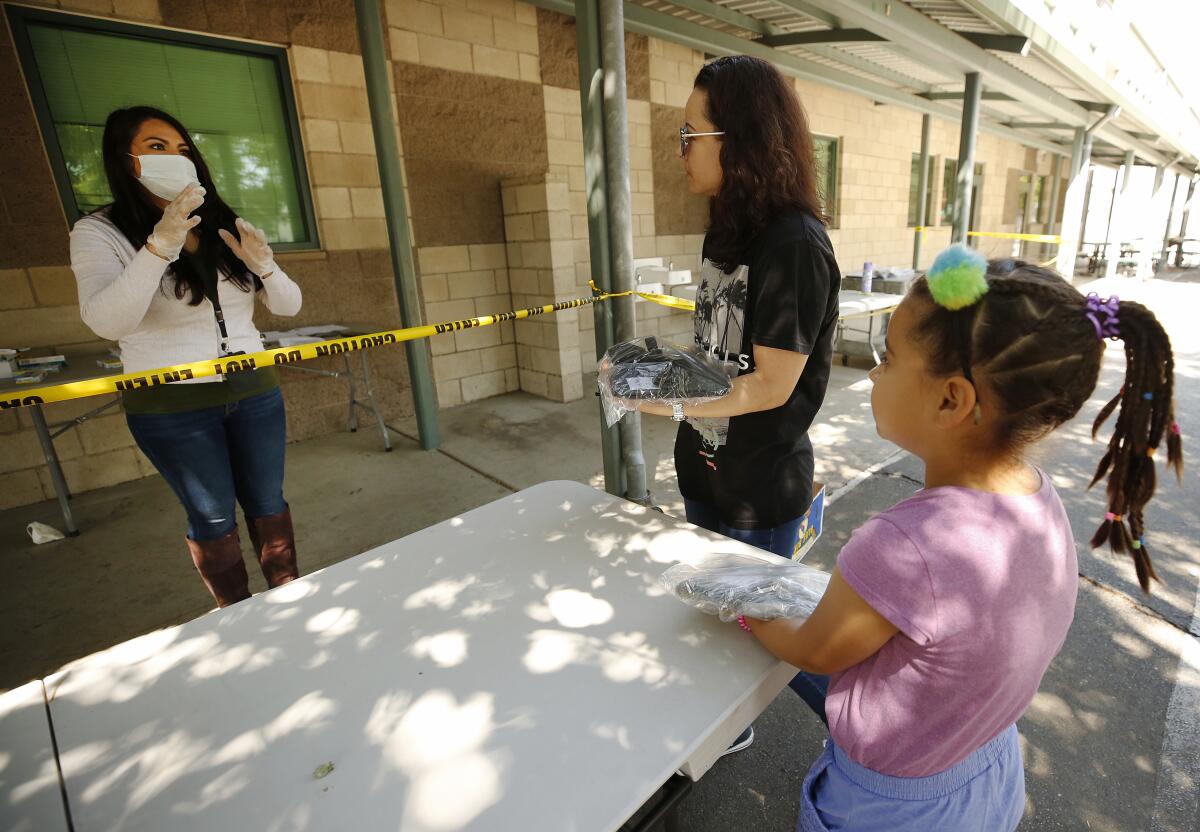Launching online learning at L.A. schools during coronavirus is ‘akin to landing on the moon’

- Share via
In a sign that the digital divide may be narrowing among Los Angeles public high school students who have lacked computer or internet access, teachers have connected with 96% of their pupils, leaving about 5,000 still unaccounted for, L.A. schools Supt. Austin Beutner said Monday.
The school district also has provided computers to middle and elementary school students, and has been so focused on swiftly distributing the devices that it does not yet have a firm count of how many have been given out, the superintendent said.
A week ago, about 15,000 high school students were missing online or had not connected with their teachers since the school district closed campuses on March 16 and began the challenging move to online learning.
“Even in the best of times, launching a comprehensive online learning program in the nation’s second-largest school district would be a monumental task, akin to landing on the moon,” said Beutner in a video update. “It would take years of careful planning, investment, training and engagement with the entire school community. During extended school closures due to the coronavirus, Los Angeles Unified is doing it in a matter of weeks, because students most in need are counting on us.”
The online sign-in numbers have been particularly low among elementary school students with just 59% logging into the district’s learning management system by Friday, the last day before spring break. But the number is difficult to interpret and does not necessarily indicate that children were not attempting schoolwork, Beutner said. Many were sent home with books and thick packets of assignments.
“Merely logging in does not tell us anything more than the student turned on their computer,” Beutner said. “The absence of a log-in, when a student is reading a book or working on a writing assignment, can leave a misleading digital footprint.”
The little ones “will miss the classroom setting the most,” he said, adding that so much of their day at a campus involved working together to solve math problems and learning about literacy with their teacher.
The school system is spending an estimated $100 million for internet hot spots and up to 200,000 computers.
The district has about 482,000 students in kindergarten through 12th grade and more than 75,000 employees. At times, students and teachers have been unable to access the district’s online system, which was not set up to accommodate so many simultaneous users. Engineers from Amazon are working with L.A. Unified to expand capacity, Beutner said.
Initially, the district prioritized getting high school students online, because many needed to complete credits to graduate and remain eligible for college. These students also are more accustomed to online work.
Bell High School Principal Rafael Balderas said some of those who remain disconnected at his school are students with significant disabilities who may not have experience with computers. Providing help to these students has been a challenge to school systems across the state, and for many their services have been drastically cut.
By Wednesday, Balderas’ team had distributed about 330 computers.
Yadire De Loza had not yet picked up one for her son, Oscar, a senior at Bell, who is worried about missing out on graduation festivities. She said she didn’t want to claim a laptop that other students might need more — given that their family owns a computer and an old tablet.
But the tablet wasn’t working well and the boys were trying to file assignments via smartphones because their home computer, which her husband also needed to use, was too much in demand. Second-grader Paulina was less affected initially because she was working off a 2-inch-thick homework packet. But one way or another, the family needed a technical upgrade.
So De Loza and Paulina stopped by nearby Ochoa Learning Center in Cudahy, a campus of 1,300 students in kindergarten through eighth grade. Paulina, 8, received an iPad, and her mother was given a Chromebook for Diego, who also attends Ochoa, where Principal Marcos Hernandez said the school signed out about 40 computers a day last week.
Teacher Edith Gastelum handed them the devices from behind a table to maintain social distancing. Families had appointments at staggered times, entering and exiting from a different gate to keep traffic moving in one direction. Gastelum said that iPads are easier for the younger children to manage, but that older students benefit from the functionality of laptops.

De Loza considers herself lucky — although her working hours at a restaurant have been sharply reduced, her husband still has his electronics job. The parents take turns overseeing the children at home.
Paulina sees some upside to the new routine. “Now my brothers help me a bit more,” she said. But she misses her friends — and especially her teachers.
“She’s asking every day: ‘When is this going to be finished?’” De Loza said. “‘When can I go back to school?’”
More to Read
Sign up for Essential California
The most important California stories and recommendations in your inbox every morning.
You may occasionally receive promotional content from the Los Angeles Times.











